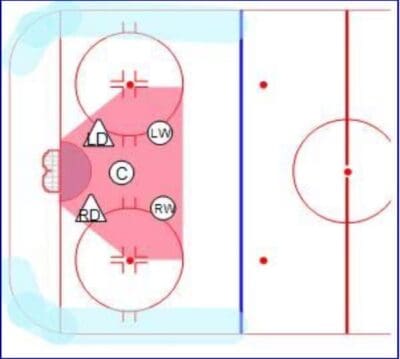Calgary Flames
Exactly What is the Calgary Flames New “Zone Defence”?

Have you ever wondered what exactly the talking heads on the Fan 960 or Sportsnet mean when they say that Calgary has adopted a “zone defence” this year? How different could it be if the Flames are once again hovering around a .500 winning percentage by late December? Luckily, we have a quick breakdown of the Calgary Flames defensive zone changes in 2023-2024.
When initially promoted to head coach in June of 2023, Ryan Huska had a tall order to carry out.
Change how the Calgary Flames attack, defend, and manage the neutral zone—no more playing man-to-man Darryl Sutter grindstone hockey. The city craved a fast, dramatic, entertaining style that would breathe fresh air into the Calgary Flames experience.
Huska laid out his plan in interviews—a higher reliance on transition play to generate offence. More speed through the neutral zone would result in a higher frequency of mistakes for both teams. More risks would be taken when leaving the defensive zone, such as wingers flying out early and relying on possession to be won before a puck battle was decided. In other words, there will be more chaos and fun while you tune in to the Flames game on any given night.
While defending their own end? Flames players would no longer stick to an assigned opposing player like glue, as was Darryl Sutter’s calling card. Calgary would implement a “zone defence” or “box plus one.”
Zone Defence
The easiest way to understand the concept of “zone defence” is to understand the primary objective of the approach: protecting the middle of the ice in the defensive zone or “home base area.”

This is done by having all five players cover an assigned area of the defensive zone. Defending players may have to alternate and swap assignments to maintain pressure as the opposing team moves the puck around. “Zone defence” will keep an active shell and wait for a misplay; a bobbled pass or a nasty pinch by a defenceman over skating the puck – there are numerous mistakes an attacking team can make while moving the puck around on NHL ice.
Courtesy of Andrew Brewer at FastModel Sports, here is what “zone defence” most commonly looks like in motion.
When a mistake is capitalized on, and possession changes hands, the defending team breaks from formation and moves to transition play out of the defensive zone and up the ice. This style benefits forwards with hard acceleration abilities, such as Nazem Kadri and Martin Pospisil, who can quickly generate space with the puck to break out of formation and start a rush offence.
Benefits
One significant benefit to playing “zone defence” is that defencemen rarely need to stray too far from their own net. Having two active sticks close to where the puck usually ends up (the net front) means that there is a good chance of mitigating rebounds on any given play.
Why is that important? With the slot clogged up with 3-5 defending players and usually one or two attacking players, attacking teams will often settle for trying to sneak a low-percentage shot through the mess of bodies with the hopes of scoring a goal off a rebound.
Interestingly, this explains a key stat recorded by the Calgary Flames this season in terms of the efficacy of having two defencemen on hand to clear rebounds, as well as a greater clog of players in front of said defencemen.
Rebounds
Dustin Wolf, Daniel Vladar, and Jacob Markstrom all rank within the bottom 34 in rebound shots against per 60 minutes at 5v5 this season. After all, NHL teams do their homework prior to playing each other and will attempt to exploit opposing defensive systems.
5v5 Rebounds per 60
Dustin Wolf: 2nd least in the NHL – 2.61
Daniel Vladar: 10th least in the NHL – 4.28
Jacob Markstrom: 34th least in the NHL – 5.5
Markstrom’s higher mark and Wolf’s lower mark can primarily be explained by timing and sample size. Markstrom was heavily relied upon during an abysmal 2-6-1 October as the team ironed out the wrinkles of a new system. Dustin Wolf played his first game on Nov. 11 and four more games in December after the team had time to adjust to a different method of defending.
In other words, the 2023-2024 Calgary Flames have proven effective at clearing rebounds. Opposing teams often have to find ways to make backdoor plays or simply hope that a rare rebound will beat the odds. Another interesting statistic is the average distance 5v5 shots are finding their way past Calgary goaltenders.
Average 5v5 Goal Against Shot Distance
Markstrom: 10th highest – 34.36ft
Daniel Vladar: 12th highest – 38.38ft
Dustin Wolf: 41st highest – 19.00ft
You can attribute Wolf’s higher mark (technically, ranks #40-41 are the league median) to a smaller sample size. Still, Markstrom and Vladar’s numbers paint a picture of a defensive system that forces the opposition to rely more on luck than most teams would prefer.
And so, we have a brand new way to enjoy watching the Calgary Flames defend their own end. Playing “zone defence” provides dramatic shot blocks, tantalizing suspense as the audience waits for the Flames to jump on a mistake and the sudden rush of seeing transition offence bloom from an abrupt change of possession. Is the system perfect? Far from it.
Weaknesses
There will always be instances where the attack simply wins the battle for the puck in the “home plate area.”
IN A BARBIE WORLD 🌎 pic.twitter.com/PYkiXFB1nE
— Vegas Golden Knights (@GoldenKnights) December 13, 2023
Sometimes the rebound shot will serve its purpose and the other team will get a lucky stick on the loose puck.
SAM ON THE DOORSTEP❗️ pic.twitter.com/iHucTSrQKC
— Vancouver Canucks (@Canucks) December 3, 2023
Other times, swapping coverage while tracking puck movement can lead to confusion about who should be where.
First hometown goal for Pointer! pic.twitter.com/zTJnZEfoCr
— Tampa Bay Lightning (@TBLightning) December 17, 2023
But with only three goals against at even strength in their last four games, there is a case to be made that the “zone defence” is finally turning a corner in Calgary. While it may be fun to work up interesting potential trades or hope for more young players to break out, it may be that the shortest route to success for the Calgary Flames is simply to keep massaging out the flaws of a new defensive system.









